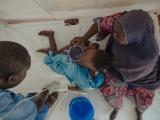The global economic burden of norovirus is a staggering $60 billion per year, with an annual death toll of 200,000, according to new estimates from a collection of studies on the disease and its impact.
The reports, published yesterday in Public Library of Science (PLoS) journals, came from a February 2015 symposium sponsored by the US Centers for Disease Control and Prevention (CDC) and the Bill and Melinda Gates Foundation. The goal of the meeting was to build a multidisciplinary knowledge base about the disease to help support the development of a vaccine targeted to one of the hardest-hit groups: children in the developing world.
Studies from the meeting tackle several norovirus topics, including global and national burden, molecular epidemiology, host-pathogen interactions, and the biological challenges in developing a vaccine, PLoS said in a press release yesterday.
Cost estimate likely conservative
Bruce Y. Lee, MD, MBA, coauthor of the economic burden study and associate professor of international health at Johns Hopkins Bloomberg School of Public Health, wrote in a blog post yesterday that, to put the annual burden into perspective, it is $15 billion more than the insurance payouts for Hurricane Katrina. He said that, depending on the country, 85% to 99% of the cost is due to productivity losses.
And that total is probably a conservative estimate, since so many norovirus infections go unreported, he wrote. "Think of how many times you do not go to the doctor when you have bad diarrhea, and if you do the cause is rarely diagnosed. So the true costs are very likely to be higher."
He added, however, that the high number in the economic impact is useful for drawing attention to the substantial impact of the disease, especially on children in developing countries.
Benjamin Lopman, PhD MSc, lead author of the collection and epidemiologist in the CDC's viral diseases division, said in a separate blog post yesterday that nearly all of the norovirus deaths occur in developing countries, where the disease is an important cause of childhood mortality.
He said two main barriers keep global health experts from making headway against the disease. One is technical issues, especially difficulties efficiently growing the virus in cell culture, a key step in developing diagnostic tests and vaccines. The second is the pervasiveness of the disease.
"Is norovirus an issue of child survival, a food safety problem, a healthcare associated infection?" he wrote. "Well, it's all of these, which may have hampered our community of researchers and public health workers from coalescing around a central problem."
Other new findings from studies in the collections revealed:
- Genetic diversity in the virus, but similar global patterns, with novel GII.4 strains replacing each other every 2 to 4 years through gene swapping
- New insights on immunity, including the possibility of raising neutralizing antibodies without using cell-culture systems
- Regional epidemiologic patterns, such as those in the United States, where rates are higher in children under age 5 and in military personnel and their families
- Prevalence and data gaps in Africa, such as rates in Kenya that are double that of developed nations and lack of information about norovirus in Africa's older adolescents and adults
- Vaccine development focusing on young children would offer the greatest global impact, though so far early trials have targeted adults in high-income settings
See also:
Apr 26 PLoS norovirus collection
Apr 26 PLoS press release
Apr 26 Lee PLoS blog post
Apr 26 Lopman PLoS blog post


















